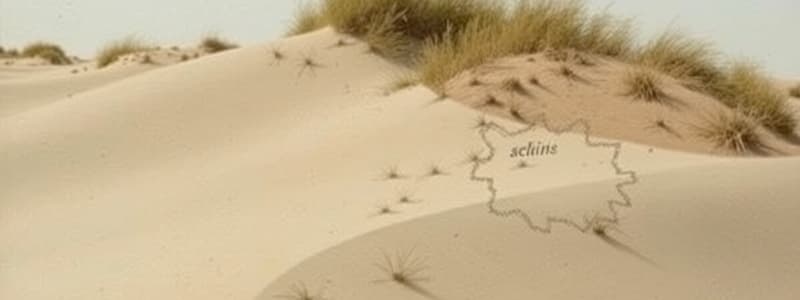Podcast
Questions and Answers
Define the term 'habitat' and briefly describe the components that constitute it.
Define the term 'habitat' and briefly describe the components that constitute it.
A habitat is a geographical or physical location where an organism lives and interacts with its surroundings. It consists of biotic and abiotic factors.
Explain how natural selection contributes to the adaptation of organisms to their environment.
Explain how natural selection contributes to the adaptation of organisms to their environment.
Natural selection drives the spread of beneficial genetic mutations, leading to adaptations that increase an organism's chances of survival in specific conditions; advantageous genetics modifications are passed down.
Describe one adaptation of the marram grass that enables it to survive in the sand dunes habitat. Explain why this habitat is challenging for most plants.
Describe one adaptation of the marram grass that enables it to survive in the sand dunes habitat. Explain why this habitat is challenging for most plants.
The marram grass has evolved specific adaptations to survive in sand dunes. Sand dunes are harsh and unstable environments because they are scarce in water with intense conditions.
What is species distribution range in the context of abiotic variables?
What is species distribution range in the context of abiotic variables?
Explain how extremes in light availability can lead to adaptations in plants, providing an example for both insufficient and excessive light conditions.
Explain how extremes in light availability can lead to adaptations in plants, providing an example for both insufficient and excessive light conditions.
Describe how symbiotic relationships can help plants adapt to poor soil quality, using legumes as an example.
Describe how symbiotic relationships can help plants adapt to poor soil quality, using legumes as an example.
How do bats and ground squirrels adapt to seasonal climate patterns to conserve energy and survive the winter months?
How do bats and ground squirrels adapt to seasonal climate patterns to conserve energy and survive the winter months?
In the context of environmental conditions, what does 'range of tolerance' refer to for an organism, and why is it important?
In the context of environmental conditions, what does 'range of tolerance' refer to for an organism, and why is it important?
Explain how climate change, pollution or habitat destruction can affect a species range of tolerance.
Explain how climate change, pollution or habitat destruction can affect a species range of tolerance.
How does the range of tolerance of a species act as a limiting factor in an ecosystem?
How does the range of tolerance of a species act as a limiting factor in an ecosystem?
Identify four key abiotic conditions that are essential for coral reef formation.
Identify four key abiotic conditions that are essential for coral reef formation.
Describe two adaptations organisms in coral reef ecosystems have developed to survive in their challenging environment.
Describe two adaptations organisms in coral reef ecosystems have developed to survive in their challenging environment.
How do temperatures and rainfall determine the type of biome?
How do temperatures and rainfall determine the type of biome?
What are the main abiotic factors that mostly determine the type of biome?
What are the main abiotic factors that mostly determine the type of biome?
Explain the difference between a biome and an ecosystem.
Explain the difference between a biome and an ecosystem.
Describe how rice plants adapt to inadequate water supply to reduce water loss, and why this adaptation is crucial for their survival?
Describe how rice plants adapt to inadequate water supply to reduce water loss, and why this adaptation is crucial for their survival?
How can changes in food supply lead to adaptations in herbivores?
How can changes in food supply lead to adaptations in herbivores?
How do camle and kangaroo rats adapt to fluctuations in water levels in arid environments to survive?
How do camle and kangaroo rats adapt to fluctuations in water levels in arid environments to survive?
How can changes in light lead to adaptations in animals?
How can changes in light lead to adaptations in animals?
Provide two examples of preferred ranges of tolerances.
Provide two examples of preferred ranges of tolerances.
Flashcards
Habitat
Habitat
A place where an organism lives and interacts with its surroundings, providing the necessary resources for survival. Includes both biotic and abiotic factors.
Adaptation
Adaptation
A genetic change that increases an organism's chances to survive in specific conditions, driven by natural selection.
Sand dunes habitat
Sand dunes habitat
Areas created by onshore winds carrying sand inland, trapped by debris or plants. Often harsh and unstable, supporting specialized plants like marram grass.
Mangrove forests habitat
Mangrove forests habitat
Signup and view all the flashcards
Species distribution range
Species distribution range
Signup and view all the flashcards
Range of tolerance
Range of tolerance
Signup and view all the flashcards
Coral reef abiotic factors
Coral reef abiotic factors
Signup and view all the flashcards
Biome
Biome
Signup and view all the flashcards
Biomes as groups of ecosystems
Biomes as groups of ecosystems
Signup and view all the flashcards
Study Notes
- Habitat is any space where an organism lives and interacts with its surroundings
- Geographical or physical locations with the necessary resources for an organism is considered a habitat
- Habitats have both biotic and abiotic factors
- Habitats can be described by their geographical location, physical location, and the larger ecosystem
- Habitats are classified as terrestrial or aquatic
Organism Adaptation
- Adaptation is a genetic change increasing an organism's chance of survival in specific conditions
- Natural selection drives the spread of beneficial genetic mutations through a population
- Organisms develop adaptations to cope with physical or abiotic conditions like temperature and light
- Organisms better adapted to their environment are more likely to survive
Sand Dune Habitats
- Sand dunes form via onshore winds carrying sand inland from the beach, with debris or plants trapping it
- These dunes are suitable for hardy beach grasses
- These dunes are difficult habitats for plants to survive because of the harsh and unstable conditions
- Marram grass adapted to sand dune survival
Mangrove Habitats
- Mangroves grow where saltwater and freshwater mix
- High salinity makes mangroves difficult places for plants to survive
- Plants such as Rhizophora apiculate have evolved specific adaptations to survive
Species Distribution
- Species distribution range refers to the geographic location and the range of occurrence
- Factors that influence species distribution are temperature, humidity, light, water, and soil
- These factors influence interactions between species and shape the distribution of living species
Plant Growth
- Plants adapt to specific abiotic conditions
- Ferns and shade-tolerant trees in areas of insufficient light grow larger, thinner leaves and increase chlorophyll content
- Succulents and cacti in areas of too much light have thick, waxy skin to retain water and reflect sunlight
- Tomato plants in areas of extreme temperatures developed heat shock proteins
- Rice plants close their stomata when there's inadequate water supply
- Legumes in areas of poor soil quality have symbiotic relationships with nitrogen-fixing bacteria
Animal Growth
- Polar bears and penguins have thick fur layers in areas of extreme temperatures
- Camels and kangaroo rats store water in their bodies in areas of fluctuating water levels
- Bats and owls are active at night in areas of changing light to avoid predators and take advantage of prey
- Herbivores in areas of food supply have specialized teeth or digestive systems to extract nutrients from tough plant material
- Bats and ground squirrels hibernate during the winter months in areas of changing climate patterns to conserve energy
Range of Tolerance
- Range of tolerance dictates the maximums that range from environmental condition, within an organism can survive and function
- Environmental changes like climate change, pollution, or habitat destruction affects tolerance
- Lions' tolerance is seasonal rainfall and high temperatures
- Polar bears' tolerance is extremely low temperatures and high salinity
- Chimpanzees' tolerance is high humidity and rainfall
- The availability of limiting factors sets the upper limit for the size of a species in an ecosystem.
Coral Reefs
- Marine ecosystems are influenced by abiotic factors, which impact survival and growth
- Calcified skeletons of coral polyps, tiny invertebrate animals, make up coral reefs
- Coral reefs are home to fish, molluscs, and sponges that provide ecosystem services such as food production
- Reefs thrive in shallow water, are sensitive to abiotic condition changes and have adapted strategies
- The water depth for coral reef formation has to be 2/3 metres
- The pH for coral reef formation has to be 8.0/8.4
- The salinity for coral reef formation has to be stable salt concentration typically from 30 to 37 ppt
- The water clarity for coral reef formation is for light to penetrate
- The temperature for coral reef formation has to be 23°/29° C
- Algae provides symbiotic relationship energy
- Camouflage allows species to blend in their surroundings to avoid predators
- Stingers and spines on species deter predators and protect themselves
- Climate change is causing death of coral reefs
Biomes
- Dominate vegetation, animals and climate pattens characterise a biome
- A biome is a large community of plants and animals in a distinct geographical region
- Taiga, tropical forest, temperate forest, grassland, tundra, and hot desert are different types of biomes
- Temperatures and rainfall are the main abiotic factors determining biome type
- Temperature affects photosynthesis, growth, and metabolism
- Rainfall determines water availability
- Biomes share similar abiotic conditions, leading to similar communities of plants and animals through convergent evolution
- Ecosystems are a smaller and more specific areas, while biomes are larger and more broady defined
Studying That Suits You
Use AI to generate personalized quizzes and flashcards to suit your learning preferences.




